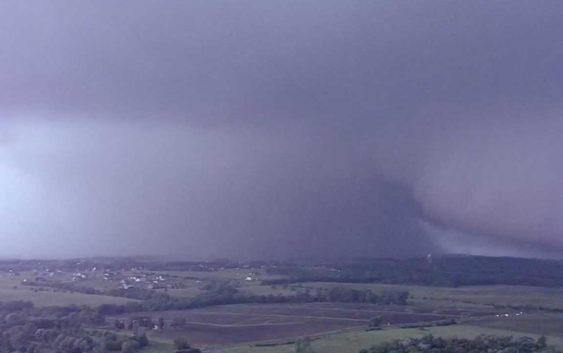- Duke Energy funding $500K to aid nonprofits in NC's post-Hurricane Helene efforts
- Duke Energy funding $500K to aid nonprofits in NC's post-Hurricane Helene efforts
- If you were affected by Hurricane Beryl or the derecho storm, you could save money on your income taxes
- Tips for filing your taxes if you were a victim of a natural disaster like Hurricane Beryl or the derecho storm
- Rain chances ramp up midweek; low-end severe weather risk
Tornadoes break record, continue into 13th straight day

As of Wednesday, there have been at least eight tornadoes per day for 13 straight days, ABC News reports. That number was already a record on Tuesday with 12 days. The previous record for consecutive days with that many tornadoes was an 11-day stretch that ended on June 7, 1980.
National Weather Service data shows that this season is on track to have the most tornadoes since 2011.
“We’re getting big counts on a lot of these days and that is certainly unusual,” said Patrick Marsh, warning coordination meteorologist for the federal Storm Prediction Center.
The National Weather Service received at least 27 more reports of tornadoes Tuesday, suggesting that the record for consecutive days would be broken once the official totals are counted.
The weather service has received 934 tornado reports so far this year as of Tuesday, up from the yearly average of 743 observed tornadoes. More than 500 of those reports came in the last 30 days. The actual number is likely lower, however, because some of the reports probably come from different witnesses who spot the same twister.
Tornado watch vs warning: What to do when you see alert messages
The U.S. has experienced a lull in the number of tornadoes since 2012, with tornado counts tracking at or below average each year and meteorologists still working to figure out why. Marsh said this month’s uptick is rare, but the country saw similar increases in 2003, 2004, 2008 and 2011 that were highly unusual at the time.
He said his agency is trying to determine why the country is seeing another surge in tornadoes after the quiet spell but doesn’t have enough data to confirm whether climate change or other forces played a role. Scientists say climate change is responsible for more intense and more frequent extreme weather such as storms, droughts, floods and fires, but without extensive study they cannot directly link a single weather event to the changing climate.
“From our point of view, there’s nothing we can definitively say as to why we’re in this current pattern,” Marsh said. “I know people want to make the jump to climate change, but tornadoes are rare in the grand scheme of things, and you need a really, really long data set (to draw any conclusions).”
The recent surge in tornado activity over the past two weeks was driven by high pressure over the Southeast and an unusually cold trough over the Rockies that forced warm, moist air into the central U.S., sparking repeated severe thunderstorms and periodic tornadoes.
“Neither one of these large systems -the high over the Southeast or the trough over the Rockies- are showing signs of moving,” Marsh said. “It’s a little unusual for them to be so entrenched this late in the season.”
Those conditions are ripe for the kind of tornadoes that have swept across the Midwest in the last two weeks, said Cathy Zapotocny, a meteorologist for the weather service in Valley, Nebraska. Zapotocny said the unstable atmosphere helped fuel many of the severe winter storms and subsequent flooding that ravaged Nebraska, Iowa and Missouri earlier this year.
“We’ve been stuck in this pattern since February,” she said.
Zapotocny said the number of tornadoes this year was “basically normal” until the surge this week. May is typically the month with the highest incidence of tornadoes, usually in the Plains and Midwestern states collectively known as Tornado Alley, where most of this year’s twisters have hit.
Most of the confirmed tornadoes were rated as less-intense EF0, EF1 and EF2s on the Enhanced Fujita Scale. But 23 were classified as EF3 tornadoes, with wind speeds of 136-165 mph. The strongest confirmed tornado this year was the EF4 tornado that killed 23 people in Alabama in March. One of this week’s tornadoes has also been confirmed as an EF4.
RELATED: What is the EF-Scale?
So far this year, 38 people have died in 10 tornadoes in the United States, including a combined seven within the last week in Iowa, Missouri, Oklahoma and Ohio.
The relative quiet in recent years followed the massive tornado that killed 161 people and injured more than 1,100 in Joplin, Missouri, in 2011. The EF5 storm packed winds in excess of 200 mph and was on the ground for more than 22 miles.
Monday’s outbreak was unusual because it occurred over a particularly wide geographic area. Eight states were affected by two regional outbreaks, in the high Plains and the Ohio River Valley.
Tornadoes strafed the Kansas City metropolitan area straddling Kansas and Missouri Tuesday night, barely a week after a massive tornado ripped through the Missouri state capital of Jefferson City.
The ABC Owned Television Stations contributed to this report.
Copyright © 2019 by The Associated Press. All Rights Reserved.